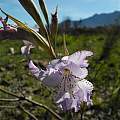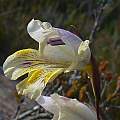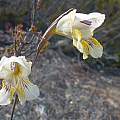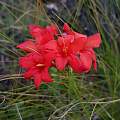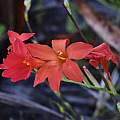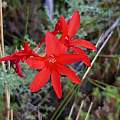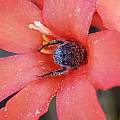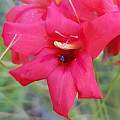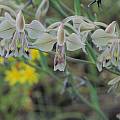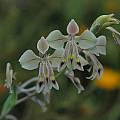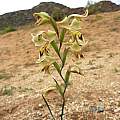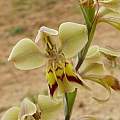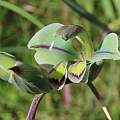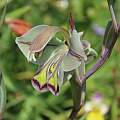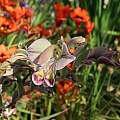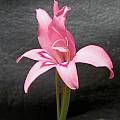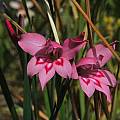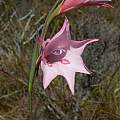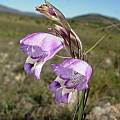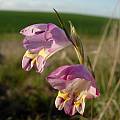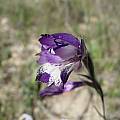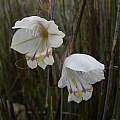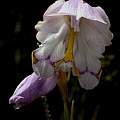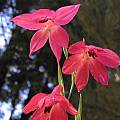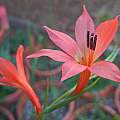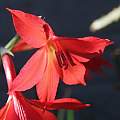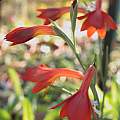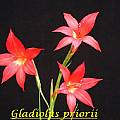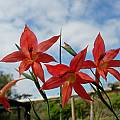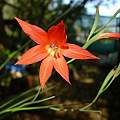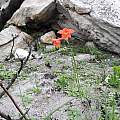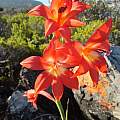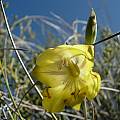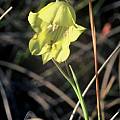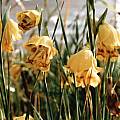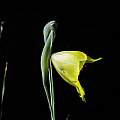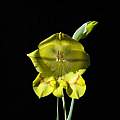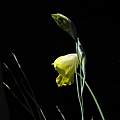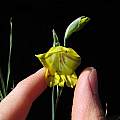Winter rain Gladiolus like their winters wet and mild and may need a dry summer dormancy. They are often less hardy, reaching down to USDA zone 8 at most.
Page 1: G. abbreviatus... Page 2: G. bonaspei... Page 3: G. carmineus... Page 4: G. debilis... Page 5: G. gracilis... Page 6: G. inflatus... Page 7: G. maculatus... Page 9: G. pulcherrimus... Page 10: G. saccatus... Page 11: G. teretifolius...
Gladiolus mutabilis is an Eastern Cape species and also occurs in the eastern part of the Western Cape. Plants grow in sandstone derived soils. This species has slightly fleshy leaf blades without thickened margins or midribs and an elongated corm that is two to three times as long as wide. Flower color ranges from pale to dark blue, mauve, brown or cream. The lower tepals are usually cream or yellow below with dark blue or brown dots and streaks on the yellow background forming the nectar guide. The fragrant flowers appear early in the season, June or July. The first photo was taken by Rachel Saunders who discovered this plant late July 2012 blooming in an area that had previously burned in the Western Cape. The next two photos were taken by Cameron McMaster August 2012 at the top of Potjiesberg Pass south of Uniondale (Eastern Cape) where it was growing with Gladiolus patersoniae. In the Western Cape population Gladiolus patersoniae was also in flower raising the question of whether they are both pollinated by the same pollinator. The last photo from the book Plants of the Klein Karoo courtesy of Jan and Anne Lise Schutte-Vlok.
Gladiolus nerineoides (N.E.Br.) G.J.Lewis is found on rocky sandstone slopes and cliffs in the southwestern Cape, flowering January-March. Growing from 35 to 60 cm high and flowering before the leaves are produced, it has funnel shaped scarlet flowers crowded together. Photos from iNaturalist taken by Peter Thompson in February and shared under a CC BY-NC license.
Gladiolus orchidiflorus Andrews is found on clay and sandstone soils from Namibia to Cape Flats and also to Free State and flowers in the spring. It has linear to sword-shaped leaves that are thickened in the midline. Flowers are in a 5 to 12 flowered spike, windowed in profile, greenish to purple with dark purple markings on the lower tepals, and are very fragrant. Photos 1-2 are habitat shots taken in Namaqualand by Bob Rutemoeller and Mary Sue Ittner September 2006. Photos 3-4 were taken near Carolusberg, Namaqualand by Cameron McMaster September 2011.
The photos below were taken by Alan Horstmann.
Gladiolus ornatus Klatt is found on marshy sandstone and granite slopes in the Southwestern Cape, South Africa. Growing from 25 to 35 cm high, it has linear leaves and pink unscented flowers in a funnel shaped tube in a one to three flowered spike. The lower tepals each have a spear to spade shaped white median streak edged in dark pink and the lower part of the throat is white streaked with dark pink. Flowering is from September to November. Photo by Rachel Saunders.
Gladiolus pappei grows in marshes on sandstone slopes in the southwestern Cape. It flowers in spring. The first two photos show a plant that was grown from Silverhill seeds sown in September 2001 and first blooming in June 2003. Photos by Bob Rutemoeller and Mary Sue Ittner. The last photo was taken by Rachel Saunders.
Gladiolus patersoniae is widespread in the southern African winter rainfall areas. It occurs in exposed rocky habitats in the interior ranges of the Cape Floral region, but also near the coast at Cape Infanta and on stony alluvial flats near Worcester. It grows on soils derived from sandstone. Plants grow to 50 cm and have narrow cylindrical leaves. The bell like short tubed and sweetly scented (similar to apple and carnation) pale to deep blue, slate, grey or cream flowers are pollinated by long tongued bees. The lower three tepals have a transverse yellow band usually outlined in dark blue or purple. Flowering occurs in late winter to spring, earlier at lower elevations. The first five photos by Cameron McMaster. His last one was taken August 2012 at the top of Potjiesberg Pass south of Uniondale (Eastern Cape) where it was growing with Gladiolus mutabilis. The last photo from the book Plants of the Klein Karoo courtesy of Jan and Anne Lise Schutte-Vlok.
Gladiolus priorii (N.E.Br.) Goldblatt & M.P.de Vos (syn. Homoglossum priorii (N.E.Br.) N.E.Br.) is a fall blooming species (April to June) found on sandstone and granite slopes in the Southwestern Cape, South Africa. Growing from 30 to 40 cm high, it has leathery linear leaves and tubular red flowers with yellow throats in a one to four flowered spike. They droop slightly, making it hard to see the centers unless you crouch down. It is considered relatively easy to grow in captivity, although Mary Sue Ittner has found in her Northern California coastal garden that it is short lived and has to be started regularly from seed. The first photo from Bob Rutemoeller shows a plant growing in the ground, flowering in November. The second photo was taken by Mary Sue Ittner, the third by Alan Horstmann, the fourth by Michael Mace, and the last by Bill Dijk.
The first two photos were taken by Cameron McMaster. The last two photos were taken by Rachel Saunders. The first of these was taken June 2011 of this species blooming on Table Mountain in the southwestern Cape in an area that had previously burned and the second in Hermanus.
Gladiolus pritzelii Diels is found on rocky sandstone slopes in the northwest Cape. It has bell-like yellow fowers with red to brown transverse markings on the lower tepals. The first photo was taken by Cameron McMaster on Ouberg Road in the Roggeveld, the second by Rod Saunders from Silverhill Seeds. The flowers have a mild scent of green apples.
The photos below are of plants in cultivation. Photo 1 was from Alan Horstmann and photos 2-5 were taken by Nhu Nguyen.
Page 1: G. abbreviatus... Page 2: G. bonaspei... Page 3: G. carmineus... Page 4: G. debilis... Page 5: G. gracilis... Page 6: G. inflatus... Page 7: G. maculatus... Page 9: G. pulcherrimus... Page 10: G. saccatus... Page 11: G. teretifolius...
